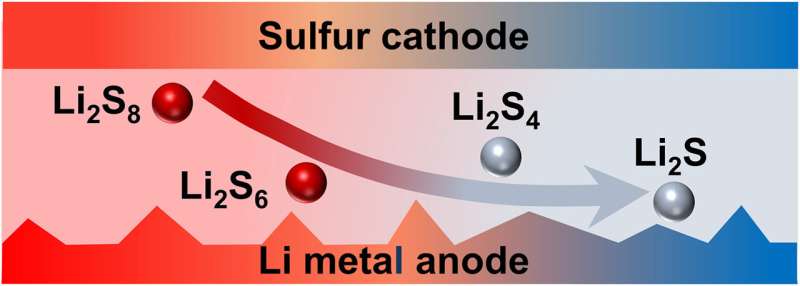Researchers explore causes of thermal runaway in lithium-sulfur batteries

A research team has conducted a systematic analysis of thermal safety in lithium-sulfur pouch cells. The team focused their study on the exothermic reactions which leads to the temperature rise of lithium-sulfur batteries after several charge-discharge cycles. Their work contributes to the understanding on thermal behaviors of lithium-sulfur batteries and offers a path toward safer, practical applications for these batteries.
The team published their findings in the journal Particuology on December 8, 2022.
Lithium metal batteries, especially lithium–sulfur batteries, have attracted significant attention because they have high theoretically specific energy density, are cost effective, and environmentally friendly. Because of their high energy density, these batteries hold the potential for use in electric vehicles and high-end portable devices.
However, there are many challenges to be addressed before practical applications of lithium-sulfur batteries can be achieved. These challenges include the "shuttle effect" of the intermediate lithium polysulfides between anodes and cathodes, the intrinsic insulation property of sulfur, and dendrite issues of lithium anode during cycles.
More importantly, the thermal safety issue that occurs because of the highly active lithium metal is an essential bottleneck for the practical applications of lithium-sulfur batteries. "Therefore, it is of great importance to investigate the key exothermic reactions which lead to the dramatic and abnormal temperature rise of lithium-sulfur batteries after several charge-discharge cycles," said Xin-Bing Cheng, a professor at Southeast University.
So the research team set out to investigate the thermal safety of deeply cycled lithium-sulfur pouch cells. They conducted a comprehensive analysis of the thermal runaway mechanisms of lithium-sulfur batteries. Thermal runaway describes the process where the battery overheats. They found that the reactions between dissolved higher-order polysulfides and lithium metal were the origins for thermal runaway in the lithium-sulfur pouch cells.
A 16-cycle pouch cell shows high safety, heating from 30 to 300°C without a dramatic temperature increase during the accelerating rate calorimeter test. By comparison, the team discovered that when 16-cycle pouch cell with additional electrolyte is heated to 147.9°C, violent exothermic reactions and the generation of tremendous heat occur.
The various thermal behaviors of these batteries are attributed to the different viscosity of electrolytes. The high viscosity of the electrolyte leads to the poor solvent's diffusion at the interface of the electrodes and electrolytes. This poor solvent's diffusion contributes to improved thermal stability between battery components at high temperature.
In contrast, the thermal behaviors for 45-cycle pouch cells with additional electrolyte is consistent with that for cells without additional electrolyte.
In their study of the 45-cycle pouch cell with an additional electrolyte, the team observed that during the accelerating rate calorimeter test, the highest temperature rate for the lithium-sulfur pouch cell after 45 cycles is just 1.72°C min−1 and its highest temperature is only 304.0°C, while the numbers are 162.4°C s−1 and 436°C respectively for the 16-cycle lithium-sulfur cells with an additional electrolyte. The various thermal behaviors of batteries are attributed to the different polysulfides species in cycled electrolytes.
"We discovered that the strong exothermic reactions between dendritic lithium and dissolved higher-order polysulfide rather than lower-order polysulfide drive the dramatic and abnormal temperature rise of deeply cycled lithium-sulfur pouch cells. Therefore, from a safety viewpoint, it is essential to inhibit the polysulfide shuttle for lithium-sulfur batteries," said Cheng.
Through their study, the team systematically revealed the thermal runaway mechanisms of cycled lithium-sulfur pouch cells. "It is important to develop effective strategies to inhibit the undesirable polysulfide shuttle and dendrite growth in Li-S batteries. Once the polysulfide shuttle and dendrite growth in lithium-sulfur batteries is suppressed completely, the thermal safety of lithium-sulfur batteries can be greatly improved," said Cheng.
More information: Xin-Bing Cheng et al, Higher-order polysulfides induced thermal runaway for 1.0 Ah lithium sulfur pouch cells, Particuology (2022). doi.org/10.1016/j.partic.2022.11.009


















